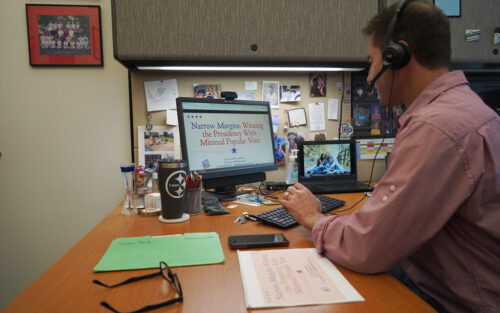Russell Goodman, professor of mathematics at Central College, presented research revealing the theoretical lowest percentage of the popular vote that a presidential candidate would need to win a presidential election.
At the Neumann University Colloquium in Philadelphia, Pennsylvania, Goodman remotely presented “Narrow Margins: Winning the Presidency with Minimal Popular Vote.” The mathematics model predicts a shocking (approximate) 20% to 24%, depending on the year.
The topic is relevant to the 2024 election identifying the candidates and their strategies for winning the presidential election. Five of 46 presidents have come into office without winning the national popular vote. Mathematicians show the data that makes it possible.
Mathematics is commonly applied to political and social science areas like voting theory and gerrymandering. Goodman’s research builds upon mathematicians George Pólya (1961) and Chuck Wessell (2012) who investigated the hypothetical question, “What is the smallest fraction of the popular vote a candidate can receive and still be elected president of the United States?”
Goodman had been reading math journals when he came across the works of Pólya and Wessell and the latest data was 11 years old. He decided to update the data models with current electoral college data and the state apportionment of delegates.
“The percentage varies depending on the number of people who vote and the number of representatives each state has based on the last census data,” Goodman says. “The answer is counterintuitive to what you would think. A candidate can win the presidential election with the smallest percentage of votes by getting as many of the small states as possible.”
Goodman admits that a candidate most likely would not legitimately win the election with only 20% of the vote, but this theory shows that it is mathematically possible.
“While this is theoretical, there is a strategy here. If a lesser-known or lesser-favored candidate strategically focused on only certain states, they could win the presidential election. It is rather shocking,” Goodman says.
“In the end, this research is all about the math and data science, not political parties or candidates,” Goodman says. “It illustrates how mathematicians and data scientists are viewing and analyzing the world in all areas of life. The cool thing about this topic is there are quite a few directions this research might go with future students who wish to collaborate.”
